Mastering the keyword technique can transform your IELTS Reading performance. Under exam pressure (60 minutes for 3 long passages and 40 questions), it’s impossible to read every word carefully. Instead, smart test-takers focus on keywords – the important content words in the questions – and hunt for their paraphrases or synonyms in the text. For example, if a passage says a “way of life,” the question might use “lifestyle.” Exam writers know this, and often paraphrase passages when crafting questions. As IELTS Simon notes, “examiners use the ‘keyword technique’ to write the questions so this is why we should use it to find the answers.” In other words, by underlining and matching keywords, you can quickly zero in on the right part of the passage. The rest of this guide will walk you through the keyword strategy step by step, with tips and practice for each question type.
Why is the keyword technique critical? Because IELTS is a reading comprehension test under time pressure, and any time you save is a score boost. Keywords (usually nouns, verbs, names, numbers, etc.) carry the key meaning in questions. Identifying them lets you scan the text rapidly. When you underline a keyword in the question, you know what to look for in the passage (or what not to look for). For example, if a True/False question mentions “Smith” or “Finland,” you scan for those terms first because names and places are easy to spot. Once you find them, you check the nearby text for the rest of the idea. This approach saves time versus reading from the top. In short, the keyword technique turns a long reading task into a targeted scavenger hunt. As one IELTS tutor puts it, “keywords are the words that carry specific information. They help a candidate identify the context of the passage [and] find the correct answer.”
Understanding Keywords and Synonyms
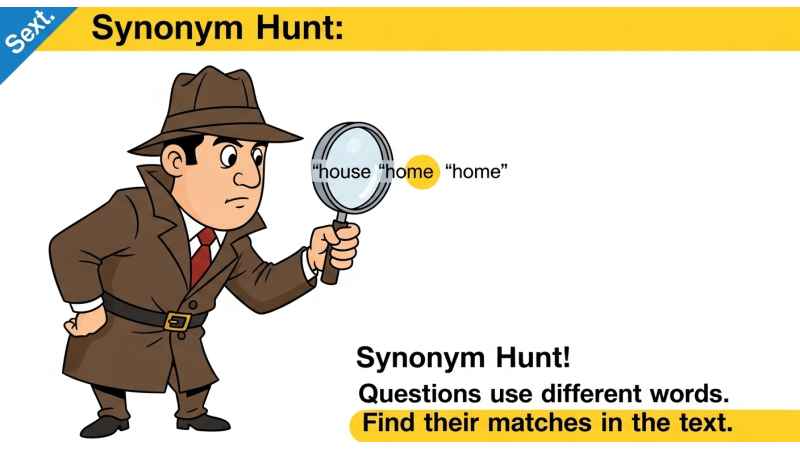
What exactly are “keywords”? These are the content words in a question that carry real meaning – things like nouns, verbs, proper names, dates, figures, or any unusual term. For example, in the question “Did Professor Jones conduct the experiment in March?”, the keywords are Professor Jones, conduct, experiment, and March. Functional words like the, of, and are not helpful, but “Professor Jones” and “March” are. IELTS guides recommend underlining or circling these keywords before you start scanning.
A quick tip: keywords often include anything capitalized, italicized, or clearly specific. The ieltsTutorials blog lists typical keywords as “nouns and verbs; names (people, places); locations; dates and years; numbers or figures; capitalized or italicized words/phrases.” These hint at the paragraph or sentence to jump to. For instance, a mention of “Brisbane” will likely appear in a geography or location-related sentence. Similarly, a phrase like “relaxed way of life” might correlate to “lifestyle” or “relax” in the text.
Once you have keywords, the next step is synonyms and paraphrases. An IELTS passage will rarely use the exact same words as the question. Instead, you must think of parallel expressions. Keyword synonyms are words or phrases in the text that have the same or very similar meaning as your question words. For example, house in the question might correspond to home in the passage. Or began might appear as started. In a famous example, “1800s” in a question matched up with “the nineteenth century” in the passage. Once you recognize that “1800s” and “nineteenth century” refer to the same time period, you know exactly which paragraph to read.
Example of keywords and synonyms: Consider this mini-passage and question:
Passage excerpt: “By 1802, shipping lanes were extremely dangerous because merchant ships were losing valuable cargo to pirates, making pirate trade highly lucrative.” Question: “In the 1800s, robbing ships was a profitable business. (True/False/Not Given)” Here the keywords are “1800s” and “robbing ships”. In the text, “1802” and “shipping lanes” are clues. You realize “1802” is the “nineteenth century,” so it matches “1800s”. The passage also says pirates stole cargo and it became a “lucrative trade,” which is a synonym for “profitable.” Seeing that connection tells you the statement conveys the same idea and should be answered True. This example from Edubenchmark shows how one must map all question keywords to the passage synonyms.
The Keyword Strategy: Step by Step
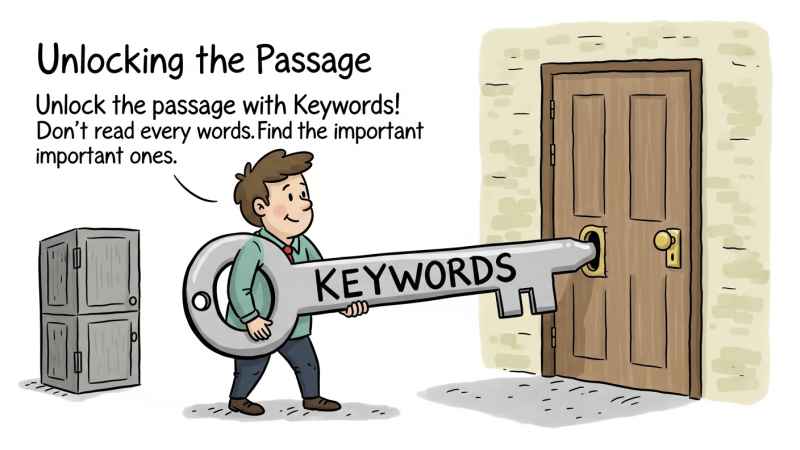
Now let’s break down the general steps of the keyword technique, which apply to every question type:
- Read the question carefully. Identify and underline all the content words – keywords – in the question or sentence. These might be nouns, verbs, adjectives, names, dates, etc. For example, in “The researchers challenged the standard theory,” underline challenged and standard theory.
- Think of synonyms/paraphrases. For each keyword, quickly brainstorm possible synonyms or related terms you might see. Even if you’re not 100% sure, having an idea helps narrow the scan. (E.g., “challenged” could be “questioned”, “rejected”; “standard theory” might be phrased as “accepted view”). IELTS experts stress that questions use different words than the passage, so paraphrasing is key.
- Scan the passage. Using the keywords (especially names, numbers, dates, places, or unique nouns) as beacons, skim the passage for those terms or their synonyms. You don’t have to read every word – run your eyes down the lines until you spot something familiar. For example, if the keyword is Brisbane, scan until you find that name. If it’s a concept like “enthusiasm”, scan for a similar word like “eagerness,” “zest,” or an antonym clue.
- Read the relevant part carefully. Once you land near the keyword (or its paraphrase), slow down and read that sentence or paragraph fully. Identify the part that directly answers the question or fills the gap. Often only a phrase or a word is needed.
- Answer with appropriate form. For gap-fill questions, pick the exact words from the passage (if instructed). For True/False, decide True if the text matches the statement, False if the text says the opposite, or Not Given if there is no clear information. In all cases, make sure the word count and grammar match the instructions (e.g. “no more than three words” etc.).
By practicing these steps, you make the keyword technique second nature. One IELTS trainer notes that at first this may seem slow, but “once you have practised this many times, you will be able to find your answers really fast and with much better accuracy.”
Study Tip: Always underline keywords in questions and write synonyms in the margin before scanning the passage. This visual cue saves time and keeps you focused. Common Trap: Don’t rely on a single word match. For example, if a heading and a paragraph share a word but have different ideas, it might be a distractor. Always check the full context of a paragraph to see its main idea.
True/False/Not Given Questions
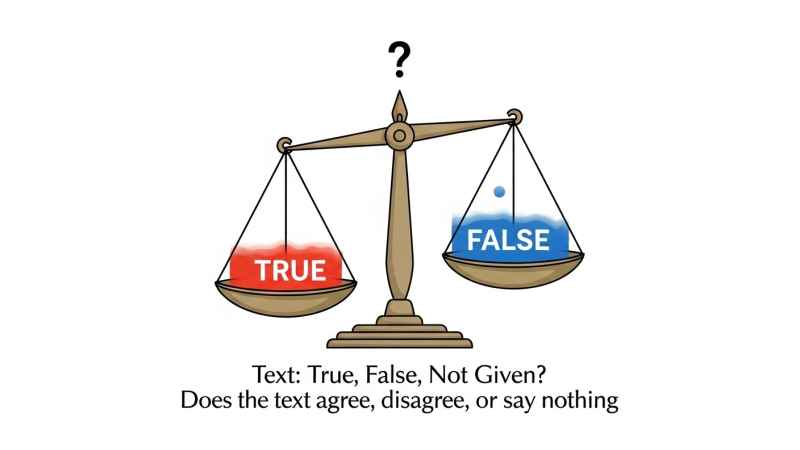
The True/False/Not Given (Academic) or Yes/No/Not Given (General) question types test your ability to judge statements against the passage. The keyword technique works beautifully here:
- Step 1: Locate by scanning. Remember that T/F/NG answers usually appear in order in the text. It’s wise to start with the easiest questions first. Scan for obvious keywords like names, places, dates, or unique nouns. For instance, if a statement mentions “Smith,” immediately look for “Smith” in the passage. Questions about “Finland” or “Brisbane” would be found by scanning those names. This quickly narrows the search.
- Step 2: Identify keywords in the statement. Underline the main idea words in the statement itself (verbs, adjectives, other nouns). For example, in “Smith challenged the standard theory,” the keywords might be Smith, challenged, standard theory. These guide you to focus on those concepts in the text.
- Step 3: Find the sentence and match meaning. Read the relevant sentence(s) from the passage. Check if the text agrees, contradicts, or has no information about the statement. If the passage clearly says the same thing, answer True (Yes). If it says the opposite, answer False. If there’s no clear support either way, answer Not Given.
- Tip: For True/False questions, notice that the keywords often imply a contrast. A True statement and a False statement will use opposite ideas. So look for negations or antonyms. For instance, if the statement is “She supported the theory,” but the passage says “She challenged the theory,” that’s directly opposite, so the answer is False. In fact, IELTS advice is to find opposite words: “Remember that a ‘True’ answer and a ‘False’ answer are opposite, so look for words you can easily make opposite to each other.” Edubenchmark’s example makes this clear: “little impact” in a question versus “shaped our world immensely” in the passage are antonyms, indicating the answer is False.
- Step 4: Don’t forget Not Given. Only use Not Given if the passage does not supply enough evidence to confirm or deny the statement. For example, the text might mention Dr. Ibrahim appeared on TV many times, but the question asks if awareness campaigns on TV are common. Since “numerous TV appearances” is not the same as “common awareness campaigns,” the answer is Not Given.
Practice Example: Suppose the passage says “Dr. Lee’s research directly challenged the accepted model.” Then a question reads: “Dr. Lee’s work supported the accepted model.” Keywords are Lee and supported. You find “Lee” in the text and see “challenged” the model. “Challenged” is the opposite of “supported,” so the correct answer is False.
Study Tip: Try turning the statement into a question (Yes/No form) to test your understanding. For example, “Were participants more accurate at identifying friends’ laughs than strangers’?” If you find nothing in the text to answer that question, it’s Not Given. This trick can clarify whether a statement has support. Common Trap: Don’t confuse similar wording with a match. A question might use a word that appears in the passage, but if the meaning is different or incomplete, don’t jump to True. Always check the full context. For example, “the pills were taken after the meeting” vs. “before the publication of research” could look similar, but time words like “after”/“before” change the meaning entirely.
Matching Headings Questions
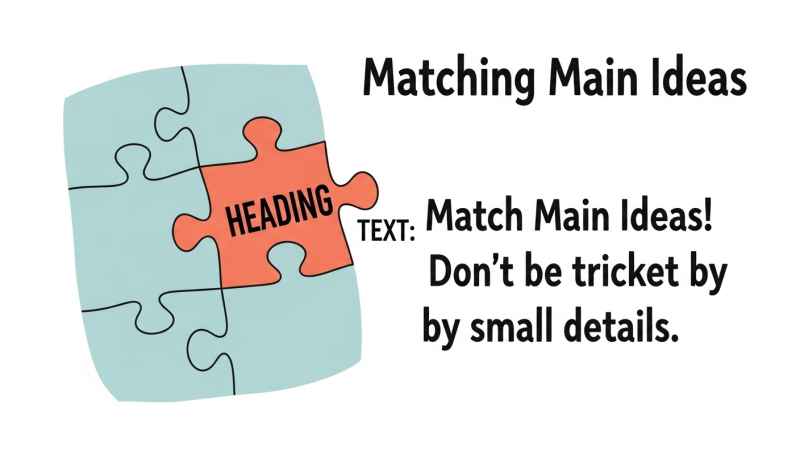
In Matching Headings (paragraph-to-heading matching), you are given a list of headings and you must choose which heading best summarizes each paragraph. The keyword technique helps here too:
- Read and analyze the headings first. Circle or underline the keywords in each heading – typically nouns and distinctive terms. For example, if a heading is “Innovations in Renewable Energy”, key words might be renewable and energy. Noting similarities or differences between headings can also help eliminate options.
- Skim the paragraph’s main idea. Read the first and last sentences of the paragraph carefully. These often contain the main point. Then skim the rest of the paragraph quickly. You’re looking for the heading’s keywords or their synonyms in context. For instance, if the heading says “tourism,” the paragraph might instead mention “visitors” or “travelers.”
- Match main ideas, not details. Remember that a heading captures the main idea, not a tiny detail. Sometimes you might see a word from a heading buried in a paragraph that’s actually about something else. The IDP tips warn: “Headings that only include specific details rather than the main idea may mislead you… the same detail … may be in the heading, but it may not be the main idea.” If the paragraph’s overall theme doesn’t fit that heading, keep scanning.
- Choose or eliminate. After skimming, pick the heading whose theme and synonyms align with the paragraph’s gist. If unsure, note it and move on; it often becomes clearer after reading other paragraphs. Sometimes headings are similar or opposite, so process of elimination helps.
Example: One heading reads “Economic Motives for Colonization”. In our earlier Australia passage, we see the paragraph mentions “strategic importance” and “economic opportunities” as reasons to colonize. The keywords economic and opportunities appear in the text. This indicates that this heading fits that paragraph.
Study Tip: When reviewing headings, paraphrase each heading in your own words. Then match it to paragraphs by looking for those ideas, not just the exact words. Common Trap: Don’t be tricked by a shared word. For example, a paragraph about an art museum might mention “modern technology,” but its main topic is art, not tech. If a heading is “Advances in Technology,” it’s wrong even if “technology” is mentioned. Always align the main idea (main topic) of the paragraph with the heading.
Sentence Completion and Gap-Fill Questions
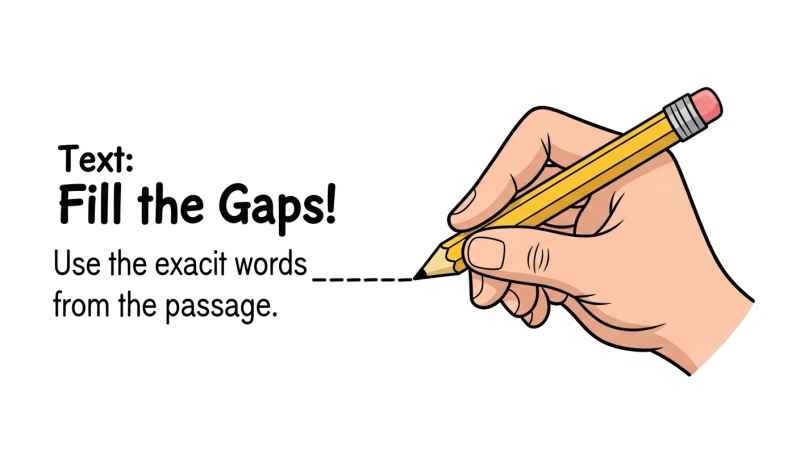
For Sentence Completion or Summary Completion tasks, the question gives a sentence (or summary) with a blank. You must fill it with words from the text (often “no more than three words”). The keyword technique guides you here as well:
- Step 1: Spot question keywords. In the incomplete sentence, underline the keywords around the blank. Also note any words that have been paraphrased. The ieltsBuddy guide stresses that “the statement will not use the same words as the text”, so you must rely on synonyms. For example, in “Britain decided to send people to live and govern Australia due to a ___ factors.”, the keywords are Britain, decided, govern, factors.
- Step 2: Find the matching sentence in the passage. Use the keywords (or their synonyms) to scan the text. In our example, scanning for Australia and reasons/factors leads to the sentence “A number of reasons contributed to Britain’s decision to colonise Australia.”
- Step 3: Transfer the exact words needed. Once you find the right sentence, see how the idea in the question maps to it. In our example, “reasons” = “factors” and “colonise” = “send people to live and govern”. The phrase “A number of” in the text corresponds to “___ factors” in the question. So the answer is “number of”.
- Step 4: Check word limit and grammar. Ensure your answer fits any word count limit and grammatically completes the sentence. Often prepositions or articles are omitted to meet the limit.
Practice Example: Look at this passage and question:
Passage: “Several violent incidents convinced the British government to relocate convicts from overcrowded prisons to the new territory.” Question: “Britain’s major reason for colonizing Australia was to relieve overcrowded ____.” Keywords: overcrowded, prisons. The text says “overcrowded prisons.” The answer is simply “prisons.” A more tricky example: “Scientists predicted a ___ in climate warming by the end of century.” If the passage said “Scientists predicted a rise in climate warming,” the blank would be “rise”. Always match form (singular/plural) as in the text.
Study Tip: Carefully consider synonyms for nouns and phrases. The example in the Australia text shows “factors” corresponds to “reasons”, and “send people to colonise” corresponds to “colonise”. Building your vocabulary of paraphrases makes this much easier over time. Common Trap: Watch for multi-word synonyms. Don’t just swap single words. For instance, if the passage has “took every factor into account” and the question has “official permission”, the answer could be a phrase from the passage (e.g. “took every factor into account” vs “official permission”). Similarly, a question blank might require two words (“number of”) to match “a number of” in the text. Assume answers can be short phrases, not necessarily a single word.
Practice Exercises
Let’s reinforce the keyword technique with a few brief practice items (answers and explanations below each).
Exercise 1 (True/False/Not Given): Passage excerpt: “In a 2020 study, Dr. Kumar disproved the long-held theory that memory retention declines sharply after age 50.” Statement: “Dr. Kumar confirmed that memory retention falls rapidly after 50.”
Identify keywords and answer T/F/NG. Answer: False. Keywords are Dr. Kumar, confirmed, memory retention, after age 50. The passage uses “disproved” (opposite of confirmed) regarding the theory that memory declines. “Confirmed” vs “disproved” are opposites, so the statement is false (it says the opposite of the passage).
Exercise 2 (Matching Headings): Paragraph: “Modern artists often blend science and creativity. They engineer new paints that react to light and even code software to generate shapes. This fusion of art and technology is pushing the boundaries of gallery installations.” Possible headings: A. Advances in Artistic Materials B. Fusion of Art and Technology C. History of Modern Art Underline keywords and match. Answer: The keywords here are engineer, paints, code, software, shapes, and “fusion of art and technology.” The paragraph is about blending art with technology. Heading B (Fusion of Art and Technology) uses very similar ideas. While “Advances in Artistic Materials” (A) shares the words “paints” and “engineer,” it doesn’t capture the bigger theme of fusion. Heading B clearly matches the main idea. This exercise shows underlining terms and finding the heading that fits the paragraph’s main idea, not just a detail.
Exercise 3 (Sentence Completion): Passage excerpt: “Urban planners predict that within twenty years, solar panels will cover most rooftops, capturing twenty percent more energy than today’s models.” Question: “Solar panels are expected to capture _______ more energy than current ones.” (No more than two words.) Identify the phrase from the text. Answer: The keywords are “capture”, “more energy”, twenty percent. In the text, the phrase “twenty percent more energy” is the answer. So the blank is “twenty percent.” (We copied the exact phrase from the passage, matching form and count.) This shows scanning for the numbers and copying the specific words needed.
Study Tips and Common Traps
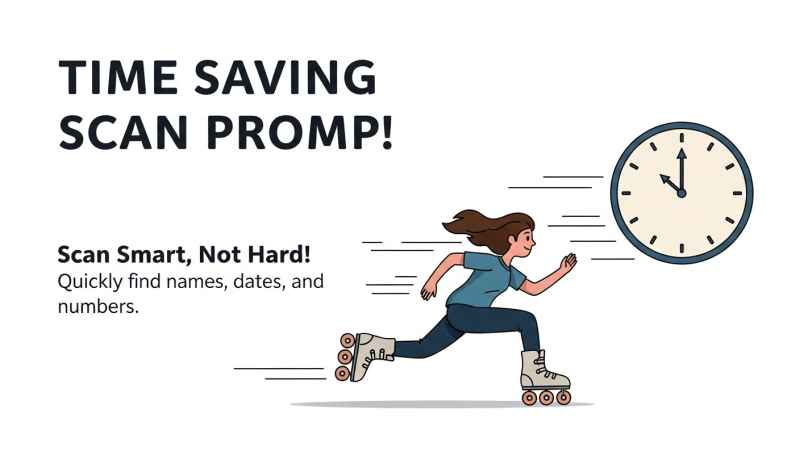
- Focus on keywords: Always start by underlining the main words in the question. This immediately tells you what to look for in the passage.
- Build your synonym bank: The more familiar you are with synonyms, the quicker you’ll match question words to the text. Practice by noticing synonyms in your everyday reading. Remember, synonyms can be single words or phrases. For example, “big impact” might appear as “had a huge effect,” or “declined” might appear as “went down significantly.”
- Beware of detail traps: In Matching Headings, don’t pick a paragraph just because one word matches. The full meaning matters. Similarly, in True/False questions, a single matching word doesn’t make the statement true if the context differs.
- Use opposites for True/False: For Yes/No/Not Given types, one powerful strategy is to turn the statement into a question and check for the answer. If you can’t find clear support, it’s probably Not Given.
- Stay calm and time-smart: Don’t get stuck. Answer as many questions as you can with these techniques, then return to harder ones if time permits. Since questions come in order, keep moving and scanning for each one’s keywords to maintain momentum.
Summary and Call to Action
The keyword technique is like having a map of the passage. By underlining content words in questions and matching them (and their synonyms) to the text, you can skip irrelevant parts and zoom straight to the answer. Over time, this becomes natural: “once you have practised this many times, you will be able to find your answers really fast and with much better accuracy.”
Now it’s up to you to apply this method consistently. Keep practicing with real IELTS passages and questions: underline the keywords in every question, search the passage for their paraphrases, and double-check each answer. With daily reading and keyword drills, you’ll build speed and accuracy. Remember that each practice session brings you closer to your target band. Stay motivated – every keyword you master is one more tool in your IELTS toolbox. Good luck, and happy practicing!

About the AuthorWelcome to TechIELTS. I’m Md. Jahangir Alam, an experienced engineer with over 15 years in electrical and automation systems. Alongside my engineering career, I’ve developed a strong interest in English language learning and IELTS preparation.
I hold a Duolingo English Test score of 135 (IELTS 7.5 equivalent) and am currently pursuing an M.Sc. in Cyber Security from Royal Holloway, University of London. I use my technical background to create clear, structured IELTS learning materials for students and professionals.
👉 Connect on LinkedIn
